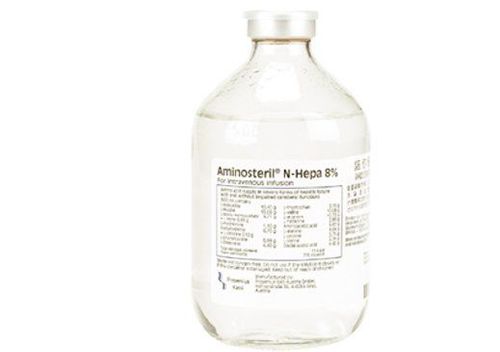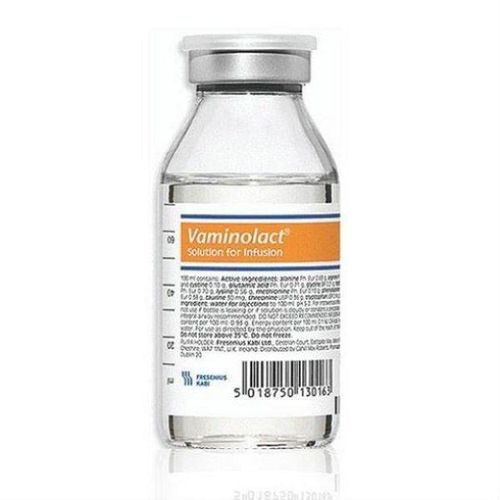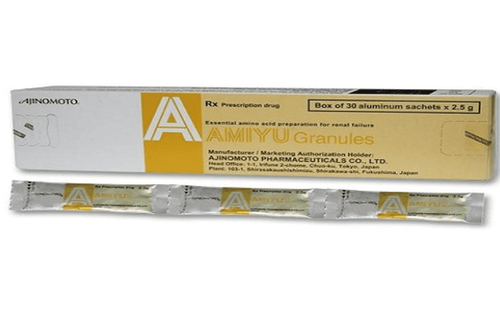This is an automatically translated article.
Aminoplasmal 10 is an infusion that provides amino acids as a substrate for protein synthesis in parenteral nutrition. So how should Aminoplasmal 10 be used effectively?
1. What is Aminoplasmal 10?
Aminoplasmal 10 is a drug on the list of electrolytes, prepared in the form of an infusion solution with the main ingredient being amino acids. Aminoplasmal 10 is intended for use in parenteral nutrition in patients who are inadequate or contraindicated when oral and enteral nutrition cannot be achieved.
Aminoplasmal 10 is indicated for use in parenteral nutrition. The drug provides amino acids as a substrate for protein synthesis in parenteral nutrition, when oral and gastrointestinal feeding is not possible or is contraindicated.
Always infuse amino acid solutions in combination with an appropriate amount of energy solution when growing intravenously. For example, in combination with carbohydrate solutions.
For patients with burns, bleeding, postoperative, cancer, poor nutrition, mild, benign gastrointestinal diseases, protein absorption disorders due to gastrointestinal tract, the drug is indicated. Aminoplasmal for prevention and treatment. Aminoplasmal 10 is also used in patients with cystic fibrosis, Crohn's disease, short bowel syndrome.
In addition, the drug is also used as parenteral nutrition in infants and premature babies. Cases of protein loss greater than 15g/day and subjects with poor food intake for more than 1 week can also use the drug.
2. Dosage and how to use Aminoplasmal 10
Dosage for adults and children aged 15 years and older
Average daily dose: Use 10-20ml/kg body weight, equivalent to 1.0 - 2.0g amino acids/kg body weight.
Patients weighing 70kg should use a dose of 1400 - 2800mi.
Maximum daily dose: Use 20ml/kg, equivalent to 2.0g amino acids/kg body weight.
Patients weighing 70kg should use a dose of 140g amino acids, equivalent to 2800 mi.
Maximum rate of infusion and drops: Use 10.0ml/kg body weight/hour, equivalent to 0.1g amino acids/kg body weight/hour, equivalent to 45 drops/min - for patients weighing 70kg, equivalent 2.34ml/min.
For children to adolescents 14 years of age: The recommended dose is a guideline value. According to each degree of the patient, the dose must be adjusted accordingly, according to the stage of disease development and disease state.
For children 3 - 5 years old, the daily dose is 15ml/kg body weight/day, equivalent to 1.5g amino acids/kg body weight/day.
For children 6-14 years old, the daily dose is 10ml/kg body weight/day and is equivalent to 1.0g amino acids/kg body weight/day.
The maximum infusion rate is 1.0ml/kg body weight/hour, corresponding to 0.1g amino acids/kg body weight/hour. In case the required amount of amino acids is 1g/kg body weight/day or more, special attention should be paid to the limit of fluid intake. Amino acid solutions may be used in larger concentrations in special cases to avoid fluid overload.
How to use intravenous infusion
Indicated when parenteral nutrition is required. Aminoplasmal 10 is only one component of parenteral nutrition. For parenteral nutrition, the supply of amino acids must be combined with the supply of energy sources, essential fatty acids, vitamins and trace elements.
3. Precautions when using Aminoplasmal 10
3.1 Contraindication Aminoplasmal 10 is contraindicated for use in the following cases:
Hypersensitivity to amino acids present in the solution Congenital abnormal amino acid metabolism Severe, potentially life-threatening circulatory disorders life-threatening such as shock Hypoxemia Metabolic acidosis Advanced liver disease Severe renal failure not requiring dialysis or hemodialysis Pathological or high serum concentrations of any of the electrolytes in the component product Children under 2 years of age are not indicated for use General contraindications in intravenous infusion such as decompensated heart failure, acute pulmonary edema, fluid retention. 3.2 Precautions Patients with disorders of amino acid metabolism when using Aminoplasmal 10 should be prescribed with caution after weighing the expected benefits and potential risks, due to reasons such as:
Need to adjust the dose for the patient with hepatic impairment, renal impairment Carefully examine patients with elevated serum osmolality If hypotonic dehydration should be corrected by providing adequate fluids and electrolytes prior to parenteral nutrition vein for the patient. During treatment, it is necessary to regularly monitor serum electrolytes, blood sugar, fluid balance, acid-base balance, kidney function (BUN, Creatinine) for the patient. Monitor serum protein and check patient liver function. Use caution when administering large volumes of fluid to patients with heart failure. Check for signs of inflammation or infection at the infusion sites. The drug does not affect the ability to drive or use machines. Aminoplasmal 10 should only be used by women who are pregnant or breastfeeding after carefully evaluating all the benefits and risks of taking the drug.
3.3 Side effects During the use of Aminoplasmal drugs, patients may experience some side effects, this is the result of parenteral nutrition, especially in the early stages of use:
Feeling feeling nauseous or vomiting Headache, chills, fever. The side effects listed above are not a complete list of all possible side effects. In case the patient uses the drug and has health problems, it is best to consult a doctor or pharmacist.
Please dial HOTLINE for more information or register for an appointment HERE. Download MyVinmec app to make appointments faster and to manage your bookings easily.













